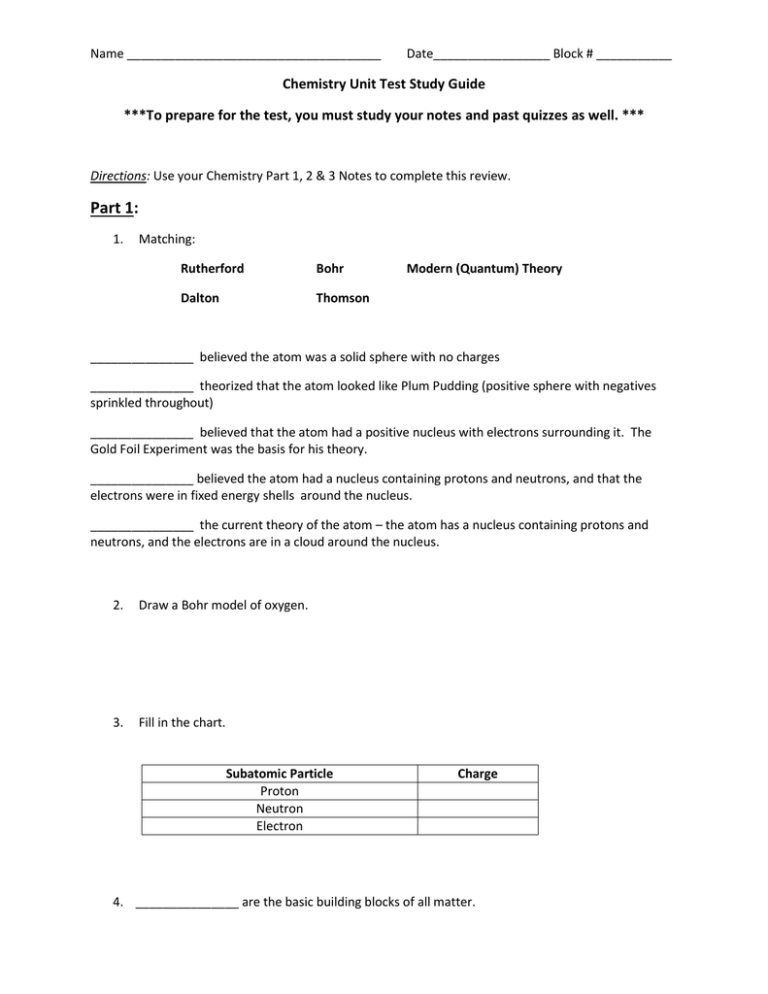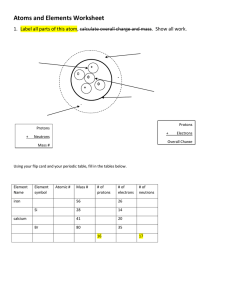Chemistry Unit Test Study Guide
advertisement

Name _____________________________________ Date_________________ Block # ___________ Chemistry Unit Test Study Guide ***To prepare for the test, you must study your notes and past quizzes as well. *** Directions: Use your Chemistry Part 1, 2 & 3 Notes to complete this review. Part 1: 1. Matching: Rutherford Bohr Dalton Thomson Modern (Quantum) Theory _______________ believed the atom was a solid sphere with no charges _______________ theorized that the atom looked like Plum Pudding (positive sphere with negatives sprinkled throughout) _______________ believed that the atom had a positive nucleus with electrons surrounding it. The Gold Foil Experiment was the basis for his theory. _______________ believed the atom had a nucleus containing protons and neutrons, and that the electrons were in fixed energy shells around the nucleus. _______________ the current theory of the atom – the atom has a nucleus containing protons and neutrons, and the electrons are in a cloud around the nucleus. 2. Draw a Bohr model of oxygen. 3. Fill in the chart. Subatomic Particle Proton Neutron Electron Charge 4. _______________ are the basic building blocks of all matter. 5. An __________________is a substance that is made entirely from one type of atom. 6. __________________ are the subatomic particles that make up protons and neutrons. 7. The atomic ____________________ is the number of protons. 8. The atomic _____________________ is the number of protons + neutrons. 9. Fill in the table below. Lithium Atomic number Atomic mass Number of protons Number of neutrons Chemical symbol State of matter at room temperature Natural or Man-made 10. An element's identity is directly related to the number of __________________in its nucleus. This is the basis for the arrangement of the elements on the periodic table. 11. What is an isotope? What is the difference between Carbon 12 and Carbon 14? Part 2: 12. Label the diagram. 13. List 4 properties of metal. 14. List 3 properties of nonmetals. 15. Describe the properties of metalloids. 16. The rows on the periodic table are called_________________. 17. The columns on the periodic table are called____________________ or _________________. 18. Which element is in the same family as Silicon? a. Carbon b. Phosphorus c. Helium 19. Which element is in the same period as Potassium? a. Titanium b. Lithium c. Boron 20. What are valence electrons? Why are they important? 21. How many valence electrons does one atom of Xenon have? 22. How many valence electrons does Aluminum have? Part 3: 23. When 2 or more different elements chemically combine together they form a ______________________. 24. When elements chemically combine they form compounds that have totally ____________ properties from themselves. 25. How many atoms total are in the following compound: 2C6H12O6 26. How many atoms of hydrogen are in the compound 3C2H6 ? 27. How many atoms of oxygen are in the compound Au(OH)3 28. Atoms bond to other atoms to become more chemically stable by having their outer energy shell _____________. 29. What is an ion? 30. In ___________________ bonding that atoms will share electrons in order to have a full outer shell. 31. In _________________ bonding a metal gives valence electrons to a nonmetal in order to have a full outer shell. Two ions are formed (one positive & one negative) and their opposite charges attract to form a compound. 32. What type of bond will each pair of atoms create? (ionic or covalent) Hydrogen and chlorine _____________________ Potassium and Iodine _______________________ Calcium and chlorine _______________________ 33. Which element is more chemically reactive, Sodium or Xenon? 34. Ionic bonds form between ___________________ and __________________. 35. Covalent bonds form between __________________ and __________________.






